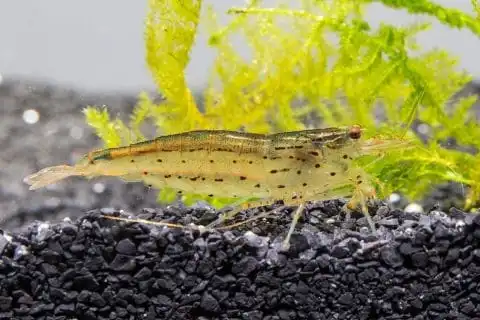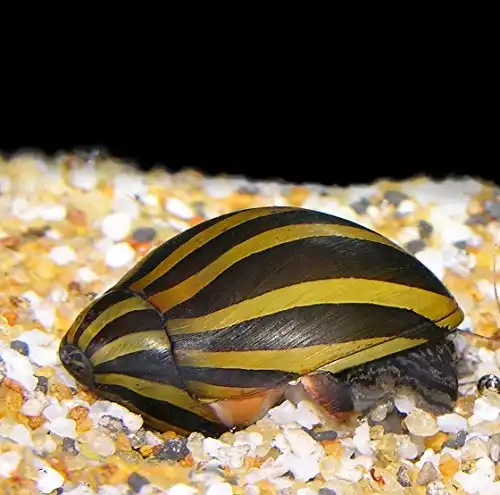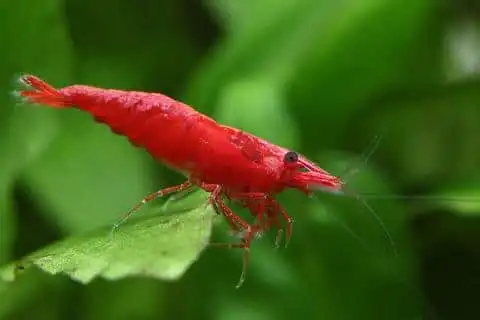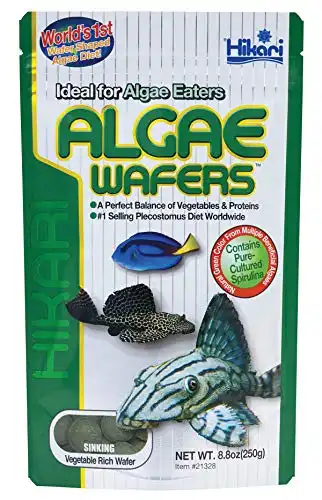Thank you for visiting! By the way… any links on this page that lead to products on Amazon and other stores/partners are affiliate links Aquarium Store Depot earns a commission if you make a purchase.
Managing algae is all part of the aquarium hobby. We all have some in our tanks, and keeping it under control can be a bit of pain. Help is available though! Did you know that there are awesome fish and animals that can eat up all the algae for you?
In this article, I’ll be introducing the 11 best algae eaters for your freshwater aquarium, so let’s get started!
What Is Algae?
Algae are types of plants that occur pretty much everywhere on the planet. They are the basis of many ecosystems and really important for all life on earth. Like other plants, algae need light, water, nutrients, and carbon dioxide to survive.
All aquariums have algae and that isn’t necessarily a bad thing. The truth is, algae don’t look great, and many aquarists would rather not see any in their tanks.
Fortunately, it is possible to suppress its growth to where it is invisible, or at least not very obvious. Before we move on to the best algae eater for your aquarium, let’s get to know the enemy.
Know Your Algae-Common types
If you have a freshwater aquarium, the chances are good that you’ve seen a few different types of algae in your tank. Here you can learn a little about the different types of algae (and bacteria) that grow in freshwater aquariums, and what causes them.
True Types
These are your common algaes that you will come across in owning an aquarium. Most are caused by excessive nutrients and can be dealt with with re-balance and algae eaters.
Green Water
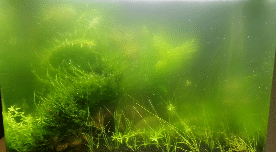
Green water is caused by tiny phytoplankton that grows in the water column. Unlike other types of algae, this phytoplankton does not need any hard surface to grow on. It isn’t as bad as it looks, and your animals will most likely be just fine in green water for short periods of time.
To prevent it from blooming, keep your water quality high. To do this, avoid overfeeding and overstocking your tank, and most importantly, make sure your aquarium is not exposed to too much light, especially direct sunlight. An aquarium UV sterilizer is also an effective solution for clearing up your water.
Green water is also a common issue with overstocked ponds or ponds with too high of a bioload.
Green Spot – GSA (Choleochaete)

This type of algae is usually seen as tiny, round green patches growing on the glass, hardscape, plant leaves, or equipment in your tank. These spots can spread to form large patches, and this type of algae can be tough to remove. Green spot algae can be caused by a lack of CO2 or phosphates in your planted aquarium.

Green Dust – GDA
Unlike the Green spot algae, green dust algae are easy to remove and tend to coat the glass of your aquarium more evenly. This green film is unsightly but pretty harmless and typically lasts for just a few weeks.
The growth of green dust algae is thought to be triggered by large changes in the tank, like replacing hardscape features or removing plants. Many algae eaters will happily feed on this type of soft algae.
Green Fuzz (Oedogonium)
Green fuzz algae are one of the types that are often referred to as filamentous algae. It tends to develop in tanks with a nutrient imbalance. This could be the result of too many nutrients in a fish-only tank or not enough nutrients in a planted tank.
Green Beard – GBA (Green Brush)

Green beard algae is a common type that can be found in both planted and fish-only tanks (picture source). To be honest, this type of algae doesn’t look all that bad, but you’ll want to prevent it anyway.
Like most algae issues, the root cause is generally a poor balance of nutrients and light.
Black Brush – BBA (Audouinella sp.) AKA Black Beard
This is the type of algae that many aquarists dread (video source). The reason is that it is tough to remove, and very few animals are interested in eating it!
Siamese algae eaters and Amano shrimps can help remove and prevent this black algae problem. Unless you or your algae eaters catch it early, you’ll probably need to get your hands wet and start scrubbing if you have a lot of it.
Blanket Weed (Cladophora)

Blanket weed looks very similar to green fuzz algae and can cover just about any surface in your aquarium, including live plants. Not many animals will feed on this algae, but invertebrates like Amano and cherry shrimp can be helpful.
Outbreaks of blanket weed tend to happen in tanks with high nutrient levels.
Green Thread
Green thread algae is another form of filamentous algae (picture source) that is common in cycling tanks. In mature aquariums, the development of this algae is the result of imbalances in light, CO2, and nutrients.
Water Silk (Spirogyra)

This type of filamentous algae (picture source) tends to occur when nutrients and light are out of balance. It can happen in planted tanks where the plant growth is poor and not able to compete with the algae.
In fish-only tanks, spikes in nutrients or ammonia could potentially cause this problem. This type of algae is better prevented than cured!
Hair (Rhizoclonium)

Hair algae create long, fine strands that often grow from aquatic plants. They can be removed manually, but luckily, many algae eaters will use them as a food source. Possible causes for the growth of this algae include nutrient imbalances and low water flow.
Staghorn (Compsopogon sp.)
This common algae type takes its name from its branches that resemble the antlers of a deer (video source). It is typically found growing on your hardscape or live plants and can be a sign of a nutrient imbalance or lack of carbon dioxide.
Other Types And Related Issues
These are other aliments your tank can experience that often times are confused with algae. I’ll break each type below and explain the causes.
Brown (Diatoms)

Diatoms are very common in new aquariums. They develop a few weeks into the life of your tank and generally do not stick around for long, usually being outcompeted by other types of algae.
If you have a mature aquarium and are still having problems with diatoms, you may want to lower the silicates in your water. Fortunately, many algae eaters love this type of brown slime algae.
Blue-Green – BGA (Cyanobacteria)
Blue-green algae is actually a form of bacteria that is common in new aquariums (video source). It is usually seen in patches on the substrate, glass, or on plants. When this occurs in mature aquariums, it is usually a sign of poor maintenance and high nutrient levels.
Surface Scum

This form of biofilm can be caused by either algae or bacteria. The best way to prevent this is to manage nutrient levels in the water, but using a surface skimmer is probably the most effective means in more stubborn tanks. Some aquarium algae eaters will also use this as a food source.
Cloudy Water

Cloudy water is a very common and normal part of the aquarium cycling process. In a newly set up tank, it tends to come and go all by itself and is nothing to worry about.
In mature tanks, however, this could be a sign of overfeeding and overstocking. A poor filtration system or something like a dead fish spoiling in the water are other possible causes. Performing regular water changes is a good way of preventing this issue.
Stained Water

If the water in your aquarium has changed from clear to yellow or brown, it has probably been stained by your hardscape. This usually happens when you add new driftwood to the tank, and tannins in the wood leach out into the water column. You can think of it like a teabag, turning the water dark.
Boiling your driftwood in water before adding it to your tank will remove these tannins much faster, but if you skipped this step, don’t worry, the wood will stop affecting water quality after a few weeks, and some water changes.
White Fungus

This nasty-looking material is pretty harmless and is very common on new driftwood. Some fish and animals will feed on it. Rest assured, white fungus on new driftwood will clear up in a matter of days or weeks.
This fungus can, however, also form on decomposing material in your tank, like a dead fish or uneaten food. These should always be removed from the tank!
12 Best Algae Eaters for Freshwater Tanks
Now that you know about the different types of algae, and have a better idea of what causes them, it’s time to meet the animals that will be more than happy to feast on the algae in your aquarium. For each algae eater, I’ll be including some vital information like:
- The type of algae they eat
- Their scientific name
- Difficulty Level
- Temperament
- Adult Size
- Minimum Tank Size
- Origin
- Temperature
- pH
- Whether they’re safe for planted tanks
So let’s get started and find the right algae eater for your tank! You can check out the video from our YouTube channel below and also see more details in the blog post below! If you like our content, be sure to subscribe!
1. Amano Shrimp
Best For Planted Tanks!
When it comes to keeping a healthy planted aquarium, Amano Shrimp are the best. These hard-working crustaceans will dutifully wipe your plants and rockwork clean of algae. Their appetite for different types of algae that can't be matched by other shrimp breeds!
- Target Algae: Varied, Hair algae, string algae, brush algae
- Scientific Name: Caridina multidentata
- Difficulty Level: Easy
- Temperament: Peaceful
- Adult Size: 2 inches
- Minimum Tank Size: 5 gallon
- Origin: Japan
- Temperature: 65-78°F
- pH: 6.5-8
- Planted Tanks: Yes
These awesome algae-eating shrimp get their name from the legendary Takashi Amano. Amano shrimp are one of the best algae eaters available and have even been reported to eat the dreaded black brush algae.
Amano shrimps are peaceful creatures and are a great option for tanks too small for algae-eating fish. They may not be the most colorful crustaceans, but these interesting invertebrates are very hard workers!
2. Otocinclus Catfish

- Target Algae: Soft green algae and diatoms
- Scientific Name: Otocinclus spp.
- Difficulty Level: Easy
- Temperament: Peaceful
- Adult Size: 2 inches
- Minimum Tank Size: 10+ gallons
- Origin: South America, Venezuela, Argentina
- Temperature: 72-79°F
- pH: 6-7.5
- Planted Tanks: Yes
The otocinclus catfish, dwarf suckerfish, or just plain oto, is probably the best nano algae-eating fish in the hobby. These small bottom dwelling fish are incredibly peaceful, and one of the few species that are 100% safe to keep with shrimp.
Otos are pretty sensitive algae-eating catfish, that need great water quality to do well. Unfortunately, many of these awesome algae eaters do not survive being transported and switched between tanks. If you are careful and take the time to acclimate them slowly, however, they can be a great solution to your algae problems!
3. Mollies

- Target Algae: Surface scum, hair algae, blanket weed algae, green fuzz algae
- Scientific Name: Poecilia spp.
- Difficulty Level: Easy
- Temperament: Peaceful
- Adult Size: up to 4.5 inches
- Minimum Tank Size: 10+ gallons
- Origin: North & South America
- Temperature: 72-78°F
- pH: 7.5-8.5
- Planted Tanks: Yes
Mollies are one of the most common aquarium fish out there, and many aquarists will be surprised to hear that they eat al. That being said, these fish might not be the best freshwater algae eaters, but they can definitely help!
One of the great benefits of these fun fish is their appetite for surface scum in the aquarium, which is something that other algae-eating fish aren’t great at controlling.
4. Horned Nerite Snail
Horned Nerite Snails are excellent algae eaters for planted tanks.
- Target Algae: Green spot algae, green dust algae, diatoms
- Scientific Name: Clithon corona
- Difficulty Level: Easy
- Temperament: Peaceful
- Adult Size: 1 inch
- Minimum Tank Size: 5 gallons
- Origin: Southeast Asia
- Temperature: 72-82°F
- pH: 7-8.2
- Planted Tanks: Yes
Horned Nerite snails are excellent algae eaters for freshwater aquariums. They can vary a lot in color but are best known for the cool ‘horns’ that grow from their shells, giving them a really unique look.
Unlike some other snails that will feed on plants or multiply out of control, these funky animals won’t give you any problems. Nerite snails are one of the only good options for removing black brush algae.
5. Zebra Nerite Snail
Nerite snails are one of the best algae eating snails you can buy. Plant safe and do not reproduce in fresh water!
- Target Algae: Green spot algae, green dust algae, diatoms
- Scientific Name: Neritina natalensis
- Difficulty Level: Easy
- Temperament: Peaceful
- Adult Size: 1 inch
- Minimum Tank Size: 5+ gallons
- Origin: Southern and Eastern Africa
- Temperature: 65-85°F
- pH: 6.5-8.5
- Planted Tanks: Yes
Zebra nerite snails are very interesting freshwater algae eaters that are a great choice for nano aquariums. These algae-eating snails can live for years and won’t reproduce in your tank like regular ramshorn snails.
Another great benefit of these algae-eating snails is that they don’t eat plants. They will lay eggs on the glass, but don’t worry, they won’t hatch and take over.
6. Tiger Nerite Snail
These Nerite Snails will eat algae, are plant safe, and do not reproduce in your aquarium!
- Target Algae: Green spot algae, green dust algae, diatoms
- Scientific Name: Vittina semiconica
- Difficulty Level: Easy
- Temperament: Peaceful
- Adult Size: 1.5 inches
- Minimum Tank Size: 5+ gallons
- Origin: Indonesia
- Temperature: 65-85°F
- pH: 6.5-8.5
- Planted Tanks: Yes
Tiger nerite snails are another excellent algae-eating snail species that have amazing shell colors and patterns. in contrast with the stripes of the zebra nerites, these snails have rows of black markings on a golden orange shell.
Like all aquarium snails, these guys will do better in harder water as this keeps their shells strong and looking great.
7. Mystery Snail

- Target Algae: Hair algae
- Scientific Name: Pomacea bridgesii
- Difficulty Level: Easy
- Temperament: Peaceful
- Adult Size: 2 inches
- Minimum Tank Size: 5 gallons
- Origin: Bolivia, Brazil, Paraguay, Peru
- Temperature: 68-82°F
- pH: 7.6-8.4
- Planted Tanks: Yes
The mystery snail is a large snail with a bright-colored shell. These snails love eating algae, but they will also feed on leftover fish food and other food sources.
While mystery snails do eat decaying plant material, they will not eat live aquarium plants, so they are a great choice for planted aquariums. Mystery snails can reproduce in your fish tank, but don’t usually breed out of control.
8. Siamese

- Target Algae: Filamentous green algae, black-brush algae
- Scientific Name: Crossocheilus langei
- Difficulty Level: Easy
- Temperament: Peaceful
- Adult Size: 7 inches
- Minimum Tank Size: 30 gallons
- Origin: Southeast Asia
- Temperature: 68-79°F
- pH: 6-7.5
- Planted Tanks: Yes
The Siamese algae eater is one of the best algae eaters for larger aquariums. These freshwater aquarium sharks grow to over 6 inches in length. Siamese algae eaters are one of the only algae eaters that will feed on black beard algae.
Take care when buying these fish because there are very similar fish known as the Chinese algae eater and the very similar flying fox. Chinese algae eaters in particular grow much larger than the Siamese algae eater and are known for some aggressive behaviors.
9. Freshwater Goby
- Target Algae: soft green algae, diatoms, blue-green algae, black brush algae
- Scientific Name: Stiphodon spp.
- Difficulty Level: Easy
- Temperament: Peaceful
- Adult Size: 2 inches
- Minimum Tank Size: 10 gallons
- Origin: Southeast Asia
- Temperature: 72-75°F
- pH: 6.5-7.5
- Planted Tanks: Yes
Stiphodon gobies (video source) are amazing algae-eating fish with a great personalities. These fish are amazing to watch as they float around the aquarium, feeding on algae that grow on the glass and other surfaces like rocks and plant leaves.
They are small algae eaters that fit in great in a community tank, just avoid keeping them with any large predatory fish.
10. Bristlenose Pleco

- Target Algae: Soft green algae, green spot algae, diatoms, white fungus
- Scientific Name: Ancistrus spp.
- Difficulty Level: Easy
- Temperament: Peaceful/ semi-aggressive
- Adult Size: 5 inches
- Minimum Tank Size: 40 gallons
- Origin: South America
- Temperature: 73-81°F
- pH: 5.8-7.2
- Planted Tanks: Yes
Bristlenose plecos are probably the most interesting-looking algae eaters available in the hobby. These effective algae-eating catfish are very peaceful with other fish but will be territorial when mature, so keep only one bristlenose in your tank.
When they’re not engaged in algae control, these fish love to hide away in a sheltered spot, so be sure to pick up some aquarium cave ornaments for them to hang out in.
11. Glass Shrimp
- Target Algae: Hair algae
- Scientific Name: Palaemonetes spp.
- Difficulty Level: Easy
- Temperament: Peaceful
- Adult Size: 1.5 inches
- Minimum Tank Size: 5+ gallons
- Origin: North America
- Temperature: 65-82°F
- pH: 7-8
- Planted Tanks: Yes
Glass shrimp or ghost shrimp as they are often known are a great member of any clean-up crew (video source). These animals aren’t going to be your first choice when picking an algae eater specifically, but they do help and are also excellent at cleaning up uneaten fish food. They are also very affordable and fascinating animals to watch!
12. Cherry Shrimp
Great red color and very hardy. Cherry shrimp are the best beginner shrimp for shrimp tanks
- Target Algae: Soft green algae, diatoms
- Scientific Name: Neocaridina heteropoda
- Difficulty Level: Easy
- Temperament: Peaceful
- Adult Size: 1.5 inches
- Minimum Tank Size: 5 gallons
- Origin: Taiwan
- Temperature: 65-85°F
- pH: 6.5-8
- Planted Tanks: Yes
Cherry shrimp are a great shrimp species for beginners. These colorful crustaceans love to feed on algae and biofilm in the aquarium, so they can really help to keep your tank looking clean. Cherry shrimp are a great choice for smaller aquariums, especially in tanks with nano fish that won’t eat them.
When To Introduce Them
Your aquarium should be fully cycled before introducing algae eaters or any other fish to the tank. It is normal to pick up a few algae problems while your tank is cycling, so avoid the urge to go out and start a whole army of algae eaters in the first few weeks.
As you know, all aquariums contain algae, but it is possible to add too many algae eaters and have them run out of food. If you have too many algae eaters, you will need to supplement their diet with other food sources.
Nano Tanks
Choosing an algae eater for your nano tank can be very tricky, especially when the aquarium is already fully stocked, or if your tank is simply too small for fish. In this case, the best way to control algae will be to introduce some inverts like freshwater snails and algae-eating shrimp. Some great nano tank mates options are listed below:
What To Feed Them
This may seem pretty obvious. They eat algae, right? Well, that’s true of course but algae growth is dynamic, and you don’t want your animals going hungry as a reward for cleaning up your tank! If your algae eaters run out of food, you can provide them with the following supplementary food sources:
- Spirulina tablets
- Algae wafers
- Blanched Vegetables
- Algae grown on pebbles
Algae wafers are a great way to directly feed your bottom feeding fish. They are especially effective for larger fish like plecos
Some of the species on my list, like mollies, are part-time algae eaters that will need a regular food supply in addition to the algae in your tank. Limiting their access to regular fish food will encourage them to focus on algae, but they will definitely need an additional food source.
What To Do If You Still Have Algae (8 Ways To Get Rid Of)
The best way to manage algae in your freshwater aquarium is definitely prevention rather than cure. In mature aquariums, algae tend to become a problem when the system is out of balance. If you still have an ongoing algae problem after introducing algae-eating animals, you’ll need to make some adjustments.
We know that algae need water, light, and nutrients to grow. Well, water is always going to be part of the equation, but as an aquarist, at least you have control over the light and nutrients in your tank.
Let’s look at other ways to reduce algae growth:
1. Grow Live Plants
Growing live plants is a great way to limit algae growth in your aquarium. Healthy, fast-growing plants like Vallisneria will out-compete the algae for nutrients while lowering the nutrient level in the water at the same time.
2. Avoid Introducing It To Your Tank
Sometimes, algae find their way into your tank on plants, and this can be the start of your problems. The best way to prevent this is to use tissue culture plants that are grown under sterile conditions.
These plants can be hard to find at your local fish store. I recommend an online store like Buceplant.com as the first place to look because they stock such an incredible range of these safe-to-grow aquatic plants.
3. Lower Your Lights
Algae often thrive under bright lights. Unless you have a planted tank, I would suggest using low-powered aquarium lights to be safe. If you prefer not to change your lights, reducing your photoperiod (day length) can also be very helpful.
For planted tanks with higher end led systems, you will need to balance light, CO2, and fertilizers. If there is an imbalance, algae will thrive.
4. Put Your Tank On A Diet
Algae need nutrients to grow. One of the biggest mistakes aquarists make is to feed their fish more than they can eat. The uneaten food then becomes a great source of nutrients for algae, which is the last thing you want!
5. Use A Remover Solution
There are many algae removing solutions out there on the market that can work on various types of algae. The one I recommend is APT Fix. This is a spot dosage treatment you can use on BBA, string, hair, fuzz, and film algae. This is a great product to use if you have a planted tank.
Use Coupon Code ASDComplete
APT Fix is a spot dosage treatment that works great for planted tanks. Effective and easy to use. Won't hurt plants or livestock
6. Avoid Overstocking
Apart from fish food, the other big source of excess nutrients in your tank is fish waste. The more fish you have, the more waste they can produce. To avoid these issues, keep your tank stocked below its maximum limit.
7. Upgrade Your Filtration
If you’re having water quality issues, it could mean your filtration system is inadequate for the size and bioload of your aquarium. Upgrading to a larger filter (like a canister filter), or even adding a second filter to the tank can be very helpful.
8. Maintenance
Even if your freshwater aquarium is stocked with the best algae-eating animals, and you’ve followed all the steps listed above, you still need to perform regular aquarium maintenance.
Make sure you perform water changes and vacuum your gravel regularly. Using an aquarium water test kit is the best way to monitor the water parameters of your tank.
Where To Buy Them
Most good pet and aquarium stores will offer at least one species of algae-eating animal for your freshwater aquarium. Instead of driving all day or calling around, I suggest checking an online store like Flipaquatics.com.
They stock a huge variety of algae-eating fish and invertebrates, and their team does an amazing job of taking care of their livestock, so you don’t have to stress about them arriving in one piece.
FAQS
Do snails eat algae?
Most aquarium snails are great at cleaning up the tank because they feed on algae and leftover fish food. The nerite snails, mystery snails, and rabbit snails are the most popular because they do not multiply. Other aquarium species like Malaysian trumpet snails and ramshorn snails also eat algae, but they can become a bit of a pest.
What kind of fish keeps the tank clean?
Luckily for aquarists, there are many excellent algae-eating fish that can keep the aquarium clean. The best algae-eating fish for freshwater aquariums are otocinclus catfish, twig catfish, bristlenose plecos, and siamese algae eaters.
What products should I use in a freshwater tank?
There are effective products on the market like API Algaefix that can be used to kill algae in your tank. A better long-term organic solution would be to introduce some algae eaters and make some adjustments to your tank’s light and nutrient levels, however.
Why does my fish tank keep turning green?
The most common reasons for algae growth in your aquarium are too much light and nutrients. If your tank is exposed to any direct sunlight, you will need to shade it or consider moving it to another position. If you keep live plants in your tank, adding more nutrients can increase plant health and help them outcompete the algae.
How big do they get?
Algae eaters range in size from tiny algae-eating shrimp to large fish that can measure over a foot in length! Be sure to research the maximum size of any animal before introducing it to your freshwater aquarium.
Final Thoughts
Using algae eaters to keep your tank clean is an amazing organic solution to pesky algae. Although the best way of managing algae is preventing its growth, algae eaters are such cool animals to keep that a little extra algae growth can be forgiven!
What are the best algae eaters that you’ve kept in your aquarium? Let me know below!
- About the Author
- Latest Posts
I’m thrilled that you found Aquarium Store Depot! Here you’ll find information on fish, aquariums, and all things aquatics related. I’m a hobbyist (being doing this since I was 11) and here to help other hobbyists thrive with their aquariums! I adhere to a high quality Editorial Process and Review products with real life field usage and practical analysis.


